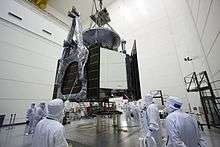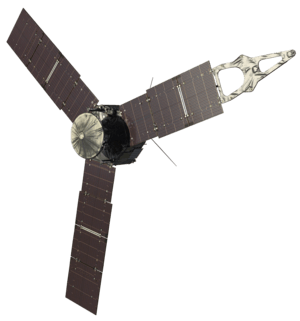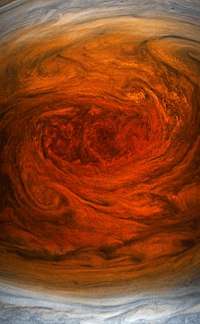Microwave Radiometer (Juno)
Microwave Radiometer (MWR) is an instrument on the Juno orbiter sent to planet Jupiter.[2] MWR is a multi-wavelength microwave radiometer for making observations of Jupiter's deep atmosphere.[3] MWR can observe radiation from 1.37 to 50 cm in wavelength, from 600 MHz to 22 GHz in frequencies.[3][4] This supports its goal of observing the previously unseen atmospheric features and chemical abundances hundreds of miles/km into Jupiter's atmosphere.[3] MWR is designed to detect six different frequencies in that range using separate antennas.[5]

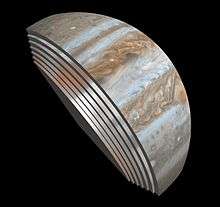
MWR views Jupiter's microwave radiation so it can see up to hundreds of miles deep into the planet.[2] In August 2016, as Juno swung closely by the planet MWR achieved a penetration of 200 to 250 miles (350 to 400 kilometers) below the surface cloud layer.[2] MWR is designed to make observations below the cloud-tops, especially detecting the abundances of certain chemicals and determine dynamic features.[3] The region has not been observed like this previously.[3]
MWR was launched aboard the Juno spacecraft on August 5, 2011 (UTC) from Cape Canaveral, USA, as part of the New Frontiers program,[6] and after an interplanetary journey that including a swingby of Earth, entered a polar orbit of Jupiter on July 5, 2016 (UTC),[7][8]
The electronics for MWR are located inside the Juno Radiation Vault, which uses titanium to protect it and other spacecraft electronics.[4][9][1] The antennas and transmission lines are designed to handle the radiation environment at Jupiter so the instrument can function.[4]
Goals
Determining the features and abundances of oxygen, nitrogen, and sulfur at up to 100 Bars of pressure (1451 psi) will shed light on the origins and nature of Jupiter.[3] It is also designed to detect the amount water and ammonia deep inside Jupiter.[5] It should also be able to provide a temperature profile of atmosphere down to 200 bar (2901 psi).[5] Overall MWR is designed to look down as deep as roughly 1,000 atmospheres (or Bars or kPa) which is about 342 miles (550 kilometers) down inside Jupiter.[10] (1 bar is roughly the pressure at Earth sea level, 14.6 psi)
One of the molecules MR is intended to look for inside Jupiter is water, which it is hoped well help explain the formation of the Solar System.[11] By probing the interior, the insights may reveal how and where Jupiter formed, in turn shedding understanding on the formation of the Earth.[11]
At the time of its use in the 2010s, it was one of only four microwave radiometers to have been flown on interplanetary spacecraft.[3] The first was Mariner 2, which used a microwave instrument to determine the high surface temperature of Venus was coming from the surface not higher up in the atmosphere.[5][3] There is also radiometer type instruments on Rosetta comet probe, and Cassini-Huygens.[3] Previously, the Galileo probe directly measured Jupiter's atmosphere in situ as it descended into the atmosphere, but only down to 22 bars of pressure.[5] However, MWR is designed to look down as deep as 1000 bar of pressure.[3] (1000 bar is about 14,500 psi, or 100000 kPa)
Antennas
MWR has six separate antennas of different size that are mounted to the sides of the Juno spacecraft body.[10] As the spacecraft turns (it is a spin-stabilzed spacecraft) each antenna takes a "swath" of observations of the giant.[10] Five of the six antennas are all on one side of the spacecraft.[10] The sixth and biggest antenna entirely fills another side the Juno body.[10]
MWR antennas:[1][10] MWR has six antennas on two different sides (it has six sides total) of Juno[10] There are two patch array antennas, three slot arrays, and one horn antenna.[10]
- 600 MHz/0.6 GHz frequency/50 cm wavelength (biggest antenna takes up one side of spacecraft body and is a patch array antenna)
- 1.2 GHz (also a patch array antenna, but located with other five antennas on one side)
- 2.4 GHz (waveguide slot array)
- 4.8 GHz (waveguide slot array)
- 9.6 GHz (waveguide slot array)
- 22 GHz frequency/1.3 cm light wavelength (horn antenna on upper deck of Juno)
As Juno turns the antennas sweep across Jupiter, each frequency/wavelength capable of seeing a certain distance below the visible cloud tops.[10]
See also Reflective array antenna and Slot antenna
Results
During a close pass in summer of 2017 when MWR was operated at Jupiter, it detected temperature changes deep within the Great Red Spot (GRS) storm.[12] On Perijove 7, which was the sixth science orbit MWR took readings of Jupiter's great red storm down to dozens of kilometers/miles of depth below the surface layers.[13]
The distribution of ammonia gas was reported on in 2017, and analyzed.[14] An ammonia rich layer was identified, as well as a belt of ammonia poor atmosphere from 5 to 20 degrees north.[14]
During the first eight orbits, WMR detected hundreds of lightning discharges, mostly in the polar regions.[15]
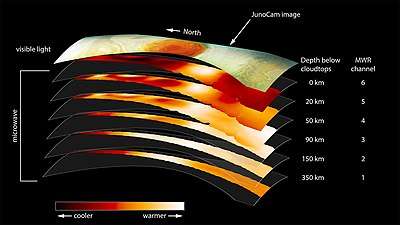
See also
- Galileo probe (in situ Atmospheric probe for Jupiter, entered and descended in 1995)
- Gravity Science
- Jovian Auroral Distributions Experiment
- Waves (Juno)
References
- "Instrument Overview – Juno". spaceflight101.com. Retrieved 2017-02-03.
- Spacecom - Jupiter's Stripes Go Deep, and Other Surprises from Juno Probe - October 2016
- Janssen, M. A.; Brown, S. T.; Oswald, J. E.; Kitiyakara, A. (2014-09-01). Juno at Jupiter: The Juno microwave radiometer (MWR). 2014 39th International Conference on Infrared, Millimeter, and Terahertz Waves (IRMMW-THZ). pp. 1–3. doi:10.1109/IRMMW-THz.2014.6956004. ISBN 978-1-4799-3877-3.
- Pingree, P.; Janssen, M.; Oswald, J.; Brown, S.; Chen, J.; Hurst, K.; Kitiyakara, A.; Maiwald, F.; Smith, S. (2008-03-01). Microwave Radiometers from 0.6 to 22 GHz for Juno, A Polar Orbiter around Jupiter. 2008 IEEE Aerospace Conference. pp. 1–15. CiteSeerX 10.1.1.473.3408. doi:10.1109/AERO.2008.4526403. ISBN 978-1-4244-1487-1.
- "Instruments and Science Data Systems - Microwave Radiometers". instrumentsanddatasystems.jpl.nasa.gov. Archived from the original on 2016-11-30. Retrieved 2017-02-03.
- Dunn, Marcia (August 5, 2011). "NASA probe blasts off for Jupiter after launch-pad snags". NBC News. Retrieved August 31, 2011.
- Chang, Kenneth (July 5, 2016). "NASA's Juno Spacecraft Enters Jupiter's Orbit". The New York Times. Retrieved July 5, 2016.
- Chang, Kenneth (June 28, 2016). "NASA's Juno Spacecraft Will Soon Be in Jupiter's Grip". The New York Times. Retrieved June 30, 2016.
- Key and Driving Requirements for the Juno Payload Suite of Instruments
- "Jupiter Orbit Insertion Press Kit | Science Overview". www.jpl.nasa.gov. Retrieved 2017-02-03.
- Musser, George. "How Juno Will Peer Deep below Jupiter's Roiling Clouds". Scientific American. Retrieved 2018-07-25.
- "Juno Probes Depths of the Great Red Spot - Sky & Telescope". Sky & Telescope. 2017-12-12. Retrieved 2018-04-04.
- "Catalog Page for PIA22177". photojournal.jpl.nasa.gov. Retrieved 2018-08-17.
- Ingersoll, Andrew P.; Adumitroaie, Virgil; Allison, Michael D.; Atreya, Sushil; Bellotti, Amadeo A.; Bolton, Scott J.; Brown, Shannon T.; Gulkis, Samuel; Janssen, Michael A. (2017-08-05). "Implications of the ammonia distribution on Jupiter from 1 to 100 bars as measured by the Juno microwave radiometer" (PDF). Geophysical Research Letters. 44 (15): 7676–7685. Bibcode:2017GeoRL..44.7676I. doi:10.1002/2017gl074277. ISSN 0094-8276.
- Brown, Shannon; Janssen, Michael; Adumitroaie, Virgil; Atreya, Sushil; Bolton, Scott; Gulkis, Samuel; Ingersoll, Andrew; Levin, Steven; Li, Cheng (June 2018). "Prevalent lightning sferics at 600 megahertz near Jupiter's poles". Nature. 558 (7708): 87–90. Bibcode:2018Natur.558...87B. doi:10.1038/s41586-018-0156-5. ISSN 0028-0836. PMID 29875484.
